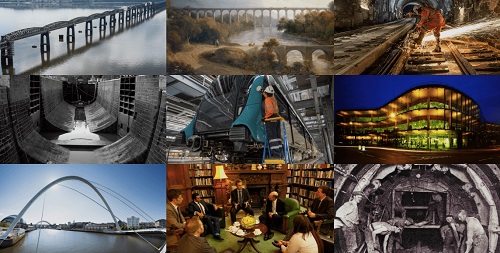2018. September 27.
The civil engineering profession was celebrated by British and Hungarian dignitaries, noted experts and members of the Academy at the opening session of a prestigious international conference in Budapest.
“Engineering is possibly the most important industrial activity that we have on this planet, since there are so many issues that we face, both climatic and social, that will require engineers, among them civil engineers, to solve”, HRH Prince Andrew, The Duke of York emphasised in his address at the opening session of the “Civil Engineer 200” conference, organised for the 200th anniversary of the establishment of ICE (Institution of Civil Engineers). The event was held in the ceremonial hall of the Hungarian Academy of Sciences and was attended by President of Hungary János Áder, Minister for Innovation and Technology László Palkovics, Hungary’s ambassador to the UK Kristóf Szalay-Bobrovniczky, Her Majesty's Ambassador to Hungary Iain Lindsay, as well as prominent members of the profession, including Rector of the Budapest University of Technology and Economics János Józsa, Dean László Dunai and university professor László Kollár (Faculty of Civil Engineering) and President of the Hungarian Chamber of Engineers Gyula Nagy. As the royal patron of ICE, the dignitary pointed out that young people should be encouraged to recognise the importance and necessity of the civil engineering profession.
“Everything around us, one way or another, is the work of engineers”, said Queen Elizabeth II’s son in praise of the civil engineering profession at the anniversary event, where the official programme also included an attraction by BME’s civil engineering students: the bridge loading test of the new Danube bridge’s model. The high-level guests watched with interest how the model responded to even double the planned static weight by slightly bending and suffering no damage.
|
The aim of the “Civil Engineer 200” conference is to present to society the benefits and results of civil engineering. An interesting reason for organising this event is that the Institution of Civil Engineers (founded in 1818 as the first chamber of civil engineers in Britain) and the European Council of Civil Engineers (ECCE) decided to celebrate 2018 as the year of civil engineers, so a number of international events are dedicated to promoting the profession. The main organisers of the two-day conference were the Hungarian Chamber of Engineers (MMK) and ICE, while BME’s Faculty of Civil Engineering was a co-organiser. The professional sessions were opened by BME’s rector János Józsa. Representing BME’s Faculty of Civil Engineering, presentations were given at the various sessions by Dean László Dunai, as well as head of department and university professor Ákos Török and associate professor Sándor Baranya. Other speakers included renowned figures in the profession from abroad, among them professor emeritus David Nethercot (Imperial College, London) and on behalf of ICE Barry Tuckwood and Brittany Harris. MKK and ICE are featured in a public exhibition entitled “We shape the future and transform the world”, organised at various locations in Budapest (for two days at Saint Stephen square in front of the Basilica, then at Szabadság square), where visitors get an insight into the various fields and tasks in civil engineering, and learn about various past and present construction projects. The exhibition is open until the end of September. According to the plans, the exhibition of 130 photos and montages will travel to other cities as well.
|
Urbanisation in Europe has reached unprecedented levels over the past 200 years, said President of Hungary János Áder, chief patron of the event in his opening address, pointing out that this progress was mainly driven by the work of civil engineers. He said of the future that the pace of urbanisation is expected to accelerate further. By 2050 three out of four people will live in an urban environment, which means that civil engineers will have even more to do, designing and building more infrastructure in future decades than in the past 2000 years; during these developments the aspects of environmental protection and sustainability must also be considered”.
“Modern civilisation cannot exist without innovative and responsible civil engineers, whose work combines state-of-the-art technology, modernity and development, as well as traditions and culture”, said Minister for Innovation and Technology László Palkovics in his welcome address, adding that “while scientists are all about ideas, engineers are all about actions”.
Engineers can only meet the challenges of the 21st century if they are prepared, have all the necessary equipment at their disposal and also have the support of society, stressed President of the Hungarian Chamber of Engineers Gyula Nagy, pointing out that the aim of the event is to showcase the works of engineers which define and shape our environment”.
The leadership of ICE and MMK decided to renew the previously signed cooperation agreement between the two organisations, within which they also selected the recipient of the Tierney Clark Award, named after the designer of the Chain Bridge (Editor's note: namesake of the Scottish engineer Adam Clark, who was in charge of building the bridge.) The award was presented jointly by President of Hungary János Áder and HRH Prince Andrew, The Duke of York.
|
The Tierney Clark Award was founded in 2000 jointly by the Midlands section of the Institution of Civil Engineers, the Hungarian Chamber of Engineers and the Association of Hungarian Consulting Engineers and Architects (TMSZ) to honour the achievements of Hungarian civil engineers. In 2018 the award was given to civil engineer László Mátyássy for the design of the Mosoni Duna Bridge, named after structural engineer Tibor Klatsmányi. The design and construction of the Haladás Sports Complex in Szombathely received a special award from the jury in recognition of structural engineer János Volkai who has passed away since the completion of the project. |
After the award ceremony János Áder and HRH Prince Andrew, The Duke of York were presented with a model of the Chain Bridge by László Szántó, President of the Structural Design Section of the Hungarian Chamber of Engineers and Dean László Dunai.
TF-GI
Photo: Philip János, epitomernok200.hu



